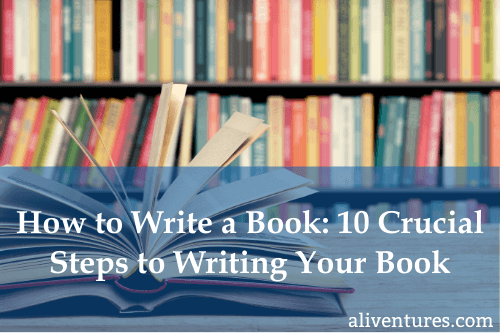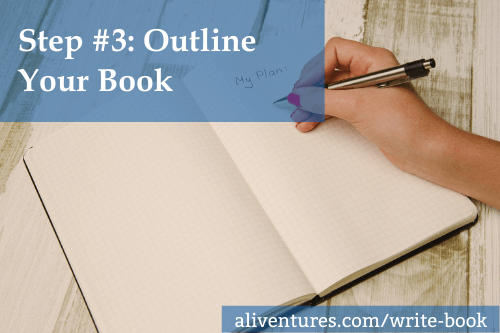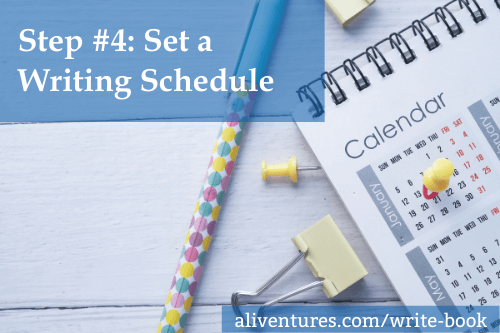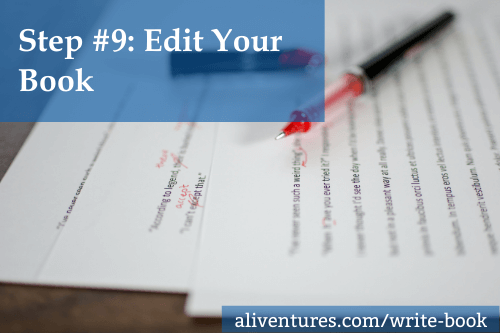How to Write a Book: 10 Crucial Steps to Writing Your Book

If you’ve never written a book before, just the thought of getting that many words down can be daunting. Where do you begin? How do you get from there to the end? Do you really have enough to say to fill up a whole book?
Even if you’re not writing a book for the first time, you might feel that you need some extra guidance. Perhaps you muddled through before, but you’re not really convinced that you actually know how to write a book.
Whether you’re planning to write a novel, a short story collection, or a non-fiction book, here are the 10 steps to writing a book, from coming up with a workable idea to publishing your book. Just click on any of these links to jump straight to that step:
- Step #1: Come Up With a Strong Idea for Your Book
- Step #2: Research Your Book Idea … But Set a Time Limit
- Step #3: Outline Your Whole Book (in As Much Detail As You Want)
- Step #4: Set a Writing Schedule That You Can Stick To
- Step #5: Write the First Draft of Your Book
- Step #6: Take a Break From Writing Your Book
- Step #7: Rewrite Your Book, From Start to End
- Step #8: Gather Feedback on Your Book
- Step #9: Edit Your Book, Incorporating Feedback
- Step #10: Publish Your Book, or Submit It to Agents and Publishers
Step #1: Come Up With a Strong Idea for Your Book

How important are ideas? Maybe not quite as important as you might think. The way you go about covering your topic or telling your story is often much more important than the underlying idea. So don’t feel that you need to spend months or years of your writing life waiting for an amazing idea to strike.
What does matter is that you have an idea that excites you. It takes a good while to write a book, and if you’re going to see it through to the end, you need to enjoy the process.
You also need an idea that people want to read about. This means that if your idea seems completely original, with nothing similar out there … you might want to rethink it. Normally, a good idea for a book will have some similarities to what’s already out there.
For fiction, that usually means writing in a recognisable genre. For non-fiction, it means picking a topic that already has an audience.
Key Tip
This (hopefully!) won’t be the only book you ever write. Don’t worry if you have several good ideas – pick one to work on for now, and store the others for later.
Equally, don’t try to cram too much material into a single book. You want enough space to dig deep into your topic, or to create an unrushed story for readers to lose themselves in.
Further Reading
For more help with coming up with ideas, check out:
- 12 Sure-Fire Ways to Find Great Ideas for Your Writing (Ali Luke, Aliventures)
- How to Develop a Great Story Idea (Jerry Jenkins, JerryJenkins.com)
- Your Next Big Book Idea: How to Figure Out Topics to Write About (James Fell, The Write Life)
- How to Be Absolutely Sure Your Book Ideas Has a Market (Chad R. Allen, ChadRAllen.com)
Step #2: Research Your Book Idea … But Set a Time Limit

Whatever type of book you’re writing, you’ll need to do some research and preparation before you begin to write.
For non-fiction, research usually involves reading other books and articles related to your topic. This lets you gather ideas about what to include in your book, learn more about your subject matter, and figure out where there might be gaps or unanswered questions in your topic area: things that you may want to address in your book.
You may also need to do interviews, depending on what sort of book you’re writing. Your research will involve figuring out who to interview and deciding what to ask them. You might want to go through step 3 (outlining) before drawing up your interview questions, so you have an idea of what to focus on.
For fiction, research can take several different forms, depending on the type of story you’re writing. If you’re writing historical fiction, you’ll need to research the time (and place) when your story is set. If you’re writing contemporary fiction set in a real world location, you’ll want to make sure your details are accurate.
You also need to do research for fantasy or science fiction. This can involve world building: dreaming up your own world and knowing the details of how it works. You may also do some research into technological advances, real-life cultures, and more.
This is also a good stage to start thinking about your characters, perhaps drawing up outlines for each of them.
Key Tip
Don’t get stuck at the research stage. If you enjoy learning about your topic (or the setting of your novel), then it’s really easy to spend too much time here. You don’t need to read every book out there, or know every detail before you start to write.
Give yourself a time limit for research, and then move on to outlining and drafting your book. You can come back and check specific facts when you get to the editing stage.
Further Reading
For more help with researching your book, check out:
- How to Research Your Novel … And When To Stop (Joanna Penn, The Creative Penn)
- Preparing to Write: Research and the Art of Narrative Nonfiction (Todd James Pierce, The Writer)
- Journalism 101: How to Do Research For a Nonfiction Story (MasterClass)
- Create a World Clinic (Holly Lisle, ebook, $9.95) (excellent, practical guide for science fiction and fantasy writers)
Step #3: Outline Your Whole Book (in As Much Detail As You Want)

Writers tend to fall into two different camps when it comes to outlining. Some writers like to plan in detail before they start writing, potentially producing an outline that works like a scaled-down first draft.
Other writers prefer to “wing it” – they want to jump in, start writing, and see where the journey takes them. They might have a rough idea of some major plot points in a novel, or some key concepts to cover in a nonfiction book, but they don’t have an overall structure.
Either method can work, but – from personal experience, and from what I’ve heard other writers say about their process – it’s definitely the case that the more you outline in advance, the less you’ll need to rework and edit your book after you finish the first draft.
With nonfiction, it’s a good idea to come up with a rough chapter by chapter outline. You’ll likely want the titles of your chapters and a couple of sentence, or a few bullet points, describing what’s going to appear in each one. If you’re aiming to get a book deal, your publisher will want an outline, and they may have specific guidelines on how to produce this.
With a novel, there are lots of different ways to create your outline: I’ve linked to some great resources in the further reading for this step. You don’t necessarily need to plan out each chapter, but it’s definitely a good idea to get clear about the key story points along the way from the beginning to the end. You’ll also want a good sense of how your story is going to end, so you know what you’re building towards as you write.
Key Tip
Your outline can (and often will) change while you’re writing the first draft. You might find that the material you’d originally planned to spend a chapter on actually needs three chapters, or that a topic you were going to cover in the second half of your book will fit better right after the introduction.
You might want to keep two versions of your outline: the original, plus a working outline that you update as you go along. That way, you can easily look back at what your initial plan was, if you feel that you’re veering off-course.
Further Reading
For more help outlining your book, check out:
- How to Outline Any Piece of Writing (Ali Luke, Aliventures)
- The Snowflake Method For Designing a Novel (Randy Ingermanson, Advanced Fiction Writing)
- 7 Ways to Outline Your Book & What To Do When You Get Stuck (Leigh Shulman, Medium.com)
- The Anatomy of Story: 22 Steps to Becoming a Master Storyteller (John Truby, book, around $12 – $15)
Step #4: Set a Writing Schedule That You Can Stick To

You might expect the next step after writing your outline to be writing a first draft – and we are going to come onto that in a moment! A trap that many would-be authors fall into, though, is not having much idea of how they’re going to write their first draft.
A book takes a lot of writing. Even if you’re writing a relatively short book – say, 30,000 words – that takes time to draft, and more time to rewrite and edit. And that time has to fit in with everything else in your life.
Of course, if you can take a couple of weeks off from work to write non-stop and hammer out a first draft of your book, by all means, do it! But for most writers – even well-established ones – writing needs to fit in around everything else in life.
You don’t need to write every day to finish a book – though of course that’s an option if it works for you. Some writers prefer to have a couple of longer writing sessions each week.
Your schedule could look something like one of these options:
- Writing every morning from 7am – 7.30am, except Sundays.
- Writing from 8pm – 9pm on Tuesday, Thursday, and Saturday evenings.
- Writing from 2pm – 3.30pm on Saturday and Sunday afternoons.
All of those add up to three hours of writing a week. It might not sound like a lot, but if you can write 500 words an hour, that’s 1,500 words a week … or 78,000 words (a full length novel) in a year.
Key Tip
Life happens. Allow room in your schedule for things going wrong.
If possible, plan a spare writing session each week so you have some catch up time if you have to cut a previous session short, or skip one altogether.
Further Reading
- Your Two-Year Plan for Writing, Editing, and Publishing Your Novel (However Busy You Are) (Ali Luke, Aliventures)
- 3 Principles for Finding Time to Write (Jane Friedman, JaneFriedman.com)
- How Do You Find Time To Write? (Joanna Penn, The Creative Penn)
- Supercharge Your Writing Session and Supercharge Your Writing Week (Ali Luke, downloadable guides, $8 each)
Step #5: Write the First Draft of Your Book

You might have expected to get to the drafting stage sooner … but all the preparation you’ve done so far has put you in a great position to begin the actual writing of your book.
This is where it all gets very real. Coming up with ideas, planning, research, and mapping out your writing schedule are all important – and they can be great fun, too. But the first draft is when you actually start creating your book.
Writing the first sentence or paragraph can be tough: you want the words to be just right. They probably won’t be, and that doesn’t matter. There’ll be plenty of opportunities to change them later. Just get something down on the page, and keep moving.
As you draft, you’ll almost certainly come to a point where you change your mind about something in your book. With non-fiction, you might realise that you need to put extra introductory material near the start to get the reader up to speed with your topic. With fiction, you might decide to cut out a character or subplot … or to add one in.
Don’t go back and make changes during the first draft. Instead, note what you want to change (maybe in your working outline document) – and carry on drafting as if you’d already made that change. By the time you finish the draft, you’ll likely have other changes you want to make too, and it’s most efficient to weave all of those in at once, instead of constantly going back and editing little bits of your book.
Important: If you’re a non-fiction writer seeking traditional publication, just work on the first 1 – 3 chapters for now. (Check the guidelines for the publisher(s) you want to submit your work to.) Then, go through the next few steps for just the initial material. The publisher may have input that changes how you approach the rest of the book.
Key Tip
You don’t have to draft your book from Chapter 1 to The End. Some writers like to start with the easiest or most compelling chapters; others like to write bits and pieces then stitch them together at the end.
Personally, I prefer to write at least mostly in order for fiction, because it’s hard to get the flow right otherwise – but there’s no rule saying you have to do it this way.
Further Reading
Eight Easy(ish) Ways to Finish the First Draft of Your Novel (Ali Luke, Aliventures)
Writing a First Draft: The No-Nonsense Guide for Authors (Bryan Collins, Become a Writer Today)
How to Write a Book: The 5-Draft Method (Jeff Goins, Goins, Writer)
The Craft of Fiction Pack and The Advanced Fiction Pack (Ali Luke, self-study seminars, $20 per pack)
Step #6: Take a Break From Writing Your Book

Once you’ve finished your first draft, you can truly say you’ve written a book. It might be rough, it might have flaws, but it’s a whole book! This is a fantastic stage to reach, because from this point on, you’re just going to be reworking the material you’ve already written.
Before you jump into rewriting, though, it’s important to take a break from writing your book. You want to be able to come back to it refreshed, rather than depleted.
Your break doesn’t need to be a long one, though I’d suggest at least a week off from writing. You might even want to plan to finish your first draft before a natural break, such as Christmas, or a family trip away. That way, you’ve got a deadline to shoot for, and you’ve got a built-in writing break afterwards.
Once you’re ready, you can carry on going with the next five steps to writing your book, which are all about getting it ready for an audience.
Key Tip
If you find it hard to take a break, or if you want to set your manuscript down for more than a couple of weeks, you might want to work on a different, short project during this time.
This is a great chance to write something just for fun: perhaps a short story, or even a few notes for your next book.
Further Reading
It’s Okay to Take a Break From Writing (Ali Luke, Aliventures)
3 Reasons You Should Take a Break From Your Writing (Emily Wenstrom, The Write Practice)
Why Doing Nothing is More Productive Than You Might Think (Ali Luke, Craft Your Content)
How Long Should You Wait Between Writing New Drafts of Your Novel? (Caroline Hardaker, Caroline Hardaker Writes)
Step #7: Rewrite Your Book, From Start to End

After writing your draft, you’re inevitably going to have some things you want to change about your book. Maybe some of the early chapters now seem tentative and faltering in tone, or perhaps you went off on a tangent part-way through that really belongs to a different book altogether.
First, read through your whole manuscript, from start to end. Don’t start editing at this point: just make notes about things that you might want to change. These could be mistakes, things that aren’t working as well as they should, or ideas that you want to make more of.
With these notes in hand, start rewriting your book. There are a few different ways you can do this, depending on what best suits your writing process.
With fiction, I usually rewrite by beginning again with a blank document and restarting the whole book. With non-fiction, I normally make a copy of the manuscript (so I can go back to the original draft if I mess something up!) and then work through it, cutting, editing, and adding material as appropriate.
Key Tip
While I think it works fine to draft your chapters out of order, if that suits you, it’s definitely best to rewrite from start to end.
That way, you can build on ideas, pick up threads that you started in earlier chapters, and refer back to things that you’ve already covered. You can also fine-tune things like character arcs and pacing, if you’re writing fiction.
Further Reading
The Four Essential Stages of Writing (for Anything You’re Working On) (Ali Luke, Aliventures)
How I Self-Edit My Novels: 15 Steps From First Draft to Publication (K.M. Weiland, Helping Writers Become Authors)
Rewriting a Novel When It’s A Big Mess (Stacy Juba, Shortcuts For Writers)
The Novel Editing Pack (Ali Luke, self-study seminars, $20)
Step #8: Gather Feedback on Your Book

Once you’ve rewritten your book, it’s hopefully getting a lot closer to what you’d originally envisaged when you first started to get your initial thoughts down on paper. It might not yet be perfect, and you might have an idea of its flaws, but this is now a great time to get feedback.
There are a number of choices when it comes to feedback. Many writers like to show their book to a supportive family member or close friend, and that can be a lovely way to help them feel involved in your work. Unless they’re also a writer, though, they’re unlikely to be able to give you all the feedback you need.
It’s also worth bringing in writing contacts: these could be friends from a workshop group, people you’ve met on a writing course, or any other writers you know in a professional context. These people can be your “beta readers” – in the same way that beta testers try out not-yet-released software, they can try out your book and make suggestions for things that might need changing.
Writing friends will often do this for free, though do be prepared to reciprocate by offering a similar level of feedback on their manuscript in the future. In the past few years, there’s also been a rise in paid beta readers: this is a great option if you want more extensive and professional feedback, don’t expect the same level of detailed edits that you’d receive from a paid editor.
Key Tip
If you plan to self-publish your book, I strongly advise paying a professional editor to go through the whole manuscript. Most will specialise in either fiction or nonfiction, and you can normally find a list of books they’ve edited – so choose an editor who will suit your type of project.
It’s worth asking around for recommendations, too, as you also want an editor who’ll you’ll get on well with. I highly recommend my own editor, Lorna Fergusson, who is both lovely and insightful.
Further Reading
What Should You Pay for When You Self-Publish a Novel? (Ali Luke, Aliventures)
12 Tips For Getting Feedback On Your Writing (Charlotte Ahlin, Bustle)
What Are Beta Readers – and How to Find Them (Reedsy)
How Peer Reviews Can Improve Your Nonfiction Book (Shelly Spencer, The Writers For Hire)
Step #9: Edit Your Book, Incorporating Feedback

Once you have feedback from your beta reader or editor, you’ll want to decide how to best incorporate their suggestions into your book. Don’t feel that you need to take every single piece of advice on board, especially with beta-readers. If something doesn’t suit your vision for your book, you don’t have to adopt it just because someone suggested it.
If several different people have independently pointed out the same issue (e.g. that your protagonist seems too passive, or that your fifth chapter is really confusing), then it’s definitely a good idea to address that. How you address it is up to you, though your beta reader or editor may have ideas that could help.
Of course, if your book is with an agent or publisher and they’ve asked for edits, you may need to make those changes even if you’re not 100% on board. Don’t be afraid to push back about edits that you disagree with, though: be polite about it, but let them know that you feel a specific change isn’t right for the book. They may well agree with you. (If they don’t, then you may feel you’re happy to compromise for the sake of publication – a perfectly reasonable decision to make.)
Some writers really enjoy editing their book, but others find this stage of the writing process a bit of a slog. You might find that it helps to set yourself specific targets, like editing a chapter each week, or editing a set number of pages every day.
Try not to get stuck at this stage for too long. You don’t want to endlessly rework the same book for years on end. There’ll always be things you could alter, or things you might add in, but at some point you do need to finish.
If you’re worried about actual mistakes (like typos or grammatical errors) in your manuscript, then it’s a good idea to hire a proofreader – or at least to ask an eagle-eyed friend to take a close look over your work.
Key Tip
If your beta reader or editor has suggested a lot of changes, and you agree with them, then treat this as a re-run of Step 7.
You’ll likely want to go through another round of feedback before making your (hopefully minor!) final edits. This is more likely to happen with fiction than nonfiction, and with your first book rather than subsequent ones.
Further Reading
25 Editing Tips for Tightening Your Copy (Plus an Editing Checklist) (Alexis Grant, The Write Life)
11 Self-Editing Tips for Getting Your Non-Fiction Into Shape (Bryan Collins, ProWritingAid)
How to Edit a Book: Your Ultimate 21-Part Checklist (Jerry Jenkins, JerryJenkins.com)
Self-Editing A Non-Fiction Book (Joanna Penn, The Creative Penn)
Step #10: Publish Your Book, or Submit it to Agents and Publishers

The final step in writing a book is to publish it, or to submit it to agents and editors. While this isn’t really part of the writing process, it’s still what many writers are ultimately aiming for. In some ways, you might feel that your book isn’t truly complete until it’s being read.
Twenty years ago, publishing a book meant sending out your manuscript to agents or publishers and hoping someone would take it on. Today, self-publishing has become a much more viable option – and one that many prolific fiction writers find much more lucrative too.
Both traditional publishing and self-publishing are perfectly valid routes. While some writers feel strongly about their chosen path, I believe that neither is “better” than the other.
They do each have some distinct advantages and disadvantages, and it’s worth being clear and realistic about these before you make a decision on how to move forward. I’ve included some useful links below to help you weigh up the pros and cons.
Key Tip
If you’re going to self-publish, pay for a professional cover design. Unless you’re a professional designer, don’t try to do the book cover by yourself – particularly for a fiction book.
If possible, pay for a professional proofreader, too. If you can’t afford that, see whether you can swap proofreading help with a writer friend.
Further Reading:
Pros And Cons Of Traditional Publishing vs Self-Publishing (Joanna Penn, The Creative Penn)
Traditional Publishing vs Self-Publishing (Jerico Writers)
Start Here: How to Get Your Book Published (Jane Friedman, JaneFriedman.com)
11 Authors Discuss the Road to Getting a Literary Agent (Stephanie Elliot, Writers’ Digest)
Learning how to write a book takes time. Some of the steps to writing a book might come easily to you – others will likely be a lot tricker. Dig into the extra resources for help, and turn to friends and family to cheer you along.
Today, set aside some time for step #1: coming up with (or developing) the idea for your book.
If you’re struggling to make time, check out Supercharge Your Writing Week. It’s designed to help you fit writing into your life – however busy you are.
About

I’m Ali Luke, and I live in Leeds in the UK with my husband and two children.
Aliventures is where I help you master the art, craft and business of writing.
Start Here
If you're new, welcome! These posts are good ones to start with:
Can You Call Yourself a “Writer” if You’re Not Currently Writing?
The Three Stages of Editing (and Nine Handy Do-it-Yourself Tips)
My Novels

My contemporary fantasy trilogy is available from Amazon. The books follow on from one another, so read Lycopolis first.
You can buy them all from Amazon, or read them FREE in Kindle Unlimited.


0 Comments